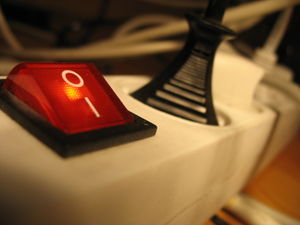Standby power
Standby power (also known as vampire power, phantom power and phantom load) refers to the electrical energy that is used by devices even when they are turned off.[2]
Causes
The following devices draw standby power:[2][3]
- Devices with a constant digital or LED display that requires power
- Devices with AC adapters, with some older types wasting nearly 50% of of the supplied energy
- Devices that can be controlled with a remote
- Devices that are often left on low-power standby, like printers
Advantages and disadvantages
Standby power is vital for devices like thermostats and telephones with answering machines, as they require constant power in order to function. It also allows for the reduction of warm-up time for electronic devices that can go into a 'sleep' or 'hibernate' mode. It also enables remotes to control devices and helps maintain internal and external digital clocks.[2][3]
Of course, the major disadvantage to standby power is the constant use of electricity. Also, devices with AC adapters often use standby energy constantly with no advantages. For example, battery chargers that are not charging a device still draw some power. Modern chargers draw an insignificant amount of electricity while in standby mode (usually less than 1 Watt) so there's no reason to unplug a cell phone charger when not in use.
Impact
The previously noted disadvantages, like wall chargers drawing power even while they aren't charging something, can lead to unnecessary costs for the consumer and environmental harm. It is estimated that between 5% and 10% of domestic electricity use in developed countries is standby power.[2]
In Canada, the impact of a single device in terms of standby power has been greatly limited due to regulations implemented by National Resources Canada in 2011.[4] Despite this, the cumulative energy used by all the devices in a home can still build up to a significant amount. In order to minimize the impact of standby power, groups of devices that use a great deal of standby power can be connected to a power strip (Figure 1) that can be turned off when the devices are not needed, or one could simply unplug devices that will not be in use for extended periods of time.[3]
References
- ↑ Wikimedia Commons [Online], Available: https://upload.wikimedia.org/wikipedia/commons/b/b6/Socket_5.jpg
- ↑ 2.0 2.1 2.2 2.3 Standby Power [Online]. Available: http://standby.lbl.gov/faq.html
- ↑ 3.0 3.1 3.2 Lamb, R. How Vampire Power Works [Online]. Available: http://electronics.howstuffworks.com/everyday-tech/vampire-power1.htm
- ↑ ARCHIVED - Standby Power Consumption - October 2011 [Online]. Available: http://www.nrcan.gc.ca/node/7251


